Taxonomy of Scheduling Problems with Learning and Deterioration Effects
Abstract
1. Introduction
2. Materials and Methods
2.1. Research Questions
2.2. Collection and Selection of Articles
- Only papers written in English were included.
- Book chapters and conference papers were not considered.
- Review papers, editorial notes, letters to the editor or similar documents were not included. Review papers were nevertheless useful in providing information on progress on this topic and were taken as a starting point for the development of this paper.
- Only papers explicitly defining a system configuration (e.g., single machine, flowshop, etc.) were included.
- Papers had to address a scheduling problem.
2.3. Analysis and Presentation of Results
3. Results
3.1. Bibliometric Analysis
3.2. Classification of Papers Related to Problem Characteristics
3.2.1. System Configuration
3.2.2. Objective Function
3.3. Modeling Approaches for Learning and Deteriorating Effects
3.3.1. Learning Effect
Position-Based Learning Effect (P-LE)
Truncated Position-Based Learning Effect (TP-LE)
Exponential Learning Effect Based on Position (EP-LE)
Sum-of-Processing-Time-Based Learning Effect (ST-LE)
Truncated Sum-of-Processing-Time-Based Learning Effect (TST-LE)
Exponential Learning Effect Based on Sum-of-Processing-Time (EST-LE)
Combining Position and Sum of Processing Time-Based Learning Effect (PST-LE)
DeJong’s Learning Effect (DJ-LE)
3.3.2. Deterioration Effect
Starting-Time Deterioration Effect (ST-DE)
Position-Based Deterioration Effect (P-DE)
Cumulative Deterioration Effect (C-DE)
3.4. Solution Methods
3.4.1. Exact Methods
3.4.2. Heuristics Leading to Optimal Solutions
3.4.3. Heuristics
3.4.4. Metaheuristics
3.4.5. Other Methods
4. Discussion
- The current results show that the literature is oriented toward the development of models, the analysis of complexity, and the design and implementation of a solution method, instead of representing the real conditions more accurately. This encourages multidisciplinary collaboration to integrate scheduling theory with human factors, experts, ergonomics, psychological issues, etc.
- There are few published articles dealing with the balance between economic and sustainable criteria (particularly as regards social orientation). It might be helpful to propose the study of scheduling problems with learning and deteriorating effects in which multiple criteria are evaluated, including social criteria.
- There are opportunities for developing studies that address the estimation of parameters such as learning, deterioration or truncation. In general, the values of these parameters are based on the literature benchmark. However, there are few articles that are strictly dedicated to estimating parameters adjusted to the problem in question.
- Every learning and deterioration model is based on one principle, such as job position or time. However, in the real world, there are other types or variables that could impact human behavior (e.g., environment, cognition, worker abilities, difficulty of work) [10,50]. The development of multivariate models for predicting worker performance, which may be incorporated into scheduling problems, is therefore relevant.
- As few articles include variables such as previous experience and task complexity in learning models [50], there is the possibility to deepen the topic to integrate these variables in models based on the position and the sum-of-processing-time. With regard to the approaches pertaining to deterioration, there is evidence of the need to integrate fatigue by addressing it through the inclusion of physiological variables, as pointed out in the literature [12]. There is likewise a need to study the effect that rest periods or rate-modifying activities (RMA) may have on performance.
- Most of the works evaluate modeling and solution approaches using theoretical problems, while few papers provide case studies [2,49,71,85]. Verification of the proposed assumptions and models for addressing the learning and deterioration effect in real-life production environments is an interesting area of research [13]. Thus, for example, collaboration with a business stakeholder makes it possible to study industrial problems with real constraints and to validate the proposed optimization methods.
- Although it is true that learning and workers’ aging or deteriorating health have a clear effect on job processing time, it is also true that there are other effects on the system performance such as errors. There are opportunities to include such factors in the scheduling problem, for example, by replacing the classical objective functions with some criteria oriented towards productivity optimization based on the minimization of faulty jobs.
5. Conclusions
Supplementary Materials
Author Contributions
Funding
Data Availability Statement
Conflicts of Interest
Appendix A
| Time related objectives (TRO) | Utilization of resources | Makespan | |
| Total resource consumption | |||
| Total load | |||
| Total idle time | |||
| Work in process | Total completion time | ||
| Total weighted completion time | |||
| Discounted total weighted completion time | |||
| Total absolute differences in completion times | |||
| The sum of the kth powers of completion times | |||
| The sum of the quadratic job completion times | |||
| Total flow time | |||
| Total absolute differences in waiting time. | |||
| Total waiting times | |||
| Cycle time | CT | ||
| Job related Objectives (JRO) | Costumer related | Maximum tardiness | |
| Maximum lateness | |||
| Maximum earliness | |||
| The number of tardy jobs | |||
| Number of just-intime jobs | |||
| Balancing related | Total tardiness | ||
| Total weighted tardiness | |||
| Total earliness | |||
| Total lateness | |||
| Cost related | Tardiness cost (penalties) | ||
| Earliness cost (penalties) | |||
| Maintenance cost or machine deterioration | |||
| Machine hiring cost | |||
| Total resources consumption cost | |||
| Sustainable objectives | Total energy consumption | ||
| Noise level | 10 * Log | ||
References
- Pinedo, M.L. Scheduling: Theory, Algorithms, and Systems; Springer: Berlin/Heidelberg, Germany, 2016; Volume 1. [Google Scholar]
- Rudek, R. Scheduling problems with position dependent job processing times: Computational complexity results. Ann. Oper. Res. 2012, 196, 491–516. [Google Scholar] [CrossRef]
- Moray, N.; Dessouky, M.I.; Kijowski, B.A.; Adapathya, R. Strategic behavior, workload, and performance in task scheduling. Hum. Factor 1991, 33, 607–629. [Google Scholar] [CrossRef]
- Dessouky, M.I.; Moray, N.; Kijowski, B. Taxonomy of scheduling systems as a basis for the study of strategic behavior. Hum. Factor 1995, 37, 443–472. [Google Scholar] [CrossRef]
- Wright, T.P. Factors Affecting the Cost of Airplanes Presented. J. Aeronaut. Sci. 1936, 3, 122–128. [Google Scholar] [CrossRef]
- Biskup, D. Single-machine scheduling with learning functions. Eur. J. Oper. Res. 1999, 115, 173–178. [Google Scholar] [CrossRef]
- Gupta, J.N.D.; Gupta, S.K. Single facility scheduling with nonlinear processing times. Comput. Ind. Eng. 1988, 14, 387–393. [Google Scholar] [CrossRef]
- Biskup, D. A state-of-the-art review on scheduling with learning effects. Eur. J. Oper. Res. 2008, 188, 315–329. [Google Scholar] [CrossRef]
- Anzanello, M.J.; Fogliatto, F.S. Alocação de modelos de produtos a equipes de trabalhadores baseada em modelos de curvas de aprendizagem. Production 2005, 15, 221–234. [Google Scholar] [CrossRef][Green Version]
- Lodree, E.J.; Geiger, C.D.; Jiang, X. Taxonomy for integrating scheduling theory and human factors: Review and research opportunities. Int. J. Ind. Ergon. 2009, 39, 39–51. [Google Scholar] [CrossRef]
- Azzouz, A.; Ennigrou, M.; Ben Said, L. Scheduling problems under learning effects: Classification and cartography. Int. J. Prod. Res. 2018, 56, 1642–1661. [Google Scholar] [CrossRef]
- Xu, S.; Hall, N.G. Fatigue, personnel scheduling and operations: Review and research opportunities. Eur. J. Oper. Res. 2021, 295, 807–822. [Google Scholar] [CrossRef]
- Glock, C.H.; Grosse, E.H.; Jaber, M.Y.; Smunt, T.L. Applications of learning curves in production and operations management: A systematic literature review. Comput. Ind. Eng. 2019, 131, 422–441. [Google Scholar] [CrossRef]
- Badger, D.; Nursten, J.; Williams, P.; Woodward, M. Should all literature reviews be systematic? Eval. Res. Educ. 2000, 14, 220–230. [Google Scholar] [CrossRef]
- Snyder, H. Literature review as a research methodology: An overview and guidelines. J. Bus. Res. 2019, 104, 333–339. [Google Scholar] [CrossRef]
- Zhu, J.; Liu, W. A tale of two databases: The use of Web of Science and Scopus in academic papers. Scientometrics 2020, 123, 321–335. [Google Scholar] [CrossRef]
- Parente, M.; Figueira, G.; Amorim, P.; Marques, A. Production scheduling in the context of Industry 4.0: Review and trends. Int. J. Prod. Res. 2020, 58, 5401–5431. [Google Scholar] [CrossRef]
- Merigó, J.M.; Yang, J.B. A bibliometric analysis of operations research and management science. Omega 2017, 73, 37–48. [Google Scholar] [CrossRef]
- Montoya-Torres, J.R.; Muñoz-Villamizar, A.; Mejia-Argueta, C. Mapping research in logistics and supply chain management during COVID-19 pandemic. Int. J. Logist. Res. Appl. 2021, 1–21. [Google Scholar] [CrossRef]
- Noyons, E.C.M.; Moed, H.F.; Luwel, M. Combining mapping and citation analysis for evaluative bibliometric purposes: A bibliometric study. J. Am. Soc. Inf. Sci. 1999, 50, 115–131. [Google Scholar] [CrossRef]
- Gaviria-Marin, M.; Merigó, J.M.; Baier-Fuentes, H. Knowledge management: A global examination based on bibliometric analysis. Technol. Forecast. Soc. Chang. 2019, 140, 194–220. [Google Scholar] [CrossRef]
- Van Eck, N.J.; Waltman, L. Software survey: VOSviewer, a computer program for bibliometric mapping. Scientometrics 2010, 84, 523–538. [Google Scholar] [CrossRef] [PubMed]
- Li, H. Stochastic Single-Machine Scheduling With Learning Effect. IEEE Trans. Eng. Manag. 2017, 64, 94–102. [Google Scholar] [CrossRef]
- Roohnavazfar, M.; Manerba, D.; Fotio Tiotsop, L.; Pasandideh, S.H.R.; Tadei, R. Stochastic single machine scheduling problem as a multi-stage dynamic random decision process. Comput. Manag. Sci. 2021, 18, 267–297. [Google Scholar] [CrossRef]
- Shen, J. Uncertain Single-Machine Scheduling with Deterioration and Learning Effect. J. Math. 2020, 2020, 7176548. [Google Scholar] [CrossRef]
- Soroush, H.M. Stochastic bicriteria single machine scheduling with sequence-dependent job attributes and job-dependent learning effects. Eur. J. Ind. Eng. 2014, 8, 421–456. [Google Scholar] [CrossRef]
- Soroush, H.M. Scheduling in bicriteria single machine systems with past-sequence- dependent setup times and learning effects. J. Oper. Res. Soc. 2014, 65, 1017–1036. [Google Scholar] [CrossRef]
- Wei, W. Single machine scheduling with stochastically dependent times. J. Sched. 2019, 22, 677–689. [Google Scholar] [CrossRef]
- Zhang, Y.; Wu, X.; Zhou, X. Stochastic scheduling problems with general position-based learning effects and stochastic breakdowns. J. Sched. 2013, 16, 331–336. [Google Scholar] [CrossRef]
- Shen, J. An uncertain parallel machine problem with deterioration and learning effect. Comput. Appl. Math. 2019, 38, 3. [Google Scholar] [CrossRef]
- Fu, Y.; Ding, J.; Wang, H.; Wang, J. Two-objective stochastic flow-shop scheduling with deteriorating and learning effect in Industry 4.0-based manufacturing system. Appl. Soft Comput. J. 2018, 68, 847–855. [Google Scholar] [CrossRef]
- Ahmadizar, F.; Hosseini, L. Single-machine scheduling with a position-based learning effect and fuzzy processing times. Int. J. Adv. Manuf. Technol. 2011, 56, 693–698. [Google Scholar] [CrossRef]
- Ahmadizar, F.; Hosseini, L. Minimizing makespan in a single-machine scheduling problem with a learning effect and fuzzy processing times. Int. J. Adv. Manuf. Technol. 2013, 65, 581–587. [Google Scholar] [CrossRef]
- Asadi, H. Apply Fuzzy Learning Effect with Fuzzy Processing Times for Single Machine Scheduling Problems. J. Manuf. Syst. 2017, 42, 244–261. [Google Scholar] [CrossRef]
- Toksan, M.D.; Ank, O.A. Single machine scheduling problems under position-dependent fuzzy learning effect with fuzzy processing times. J. Manuf. Syst. 2017, 45, 159–179. [Google Scholar]
- Arık, O.A.; Toksarı, M.D. A genetic algorithm approach to parallel machine scheduling problems under effects of position-dependent learning and linear deterioration: Genetic algorithm to parallel machine scheduling problems. Int. J. Appl. Metaheuristic Comput. 2021, 12, 195–211. [Google Scholar] [CrossRef]
- Geyik, F.; Elibal, K. A linguistic approach to non-identical parallel processor scheduling with fuzzy processing times. Appl. Soft Comput. J. 2017, 55, 63–71. [Google Scholar] [CrossRef]
- Li, K.; Chen, J.; Fu, H.; Jia, Z.; Wu, J. Parallel machine scheduling with position-based deterioration and learning effects in an uncertain manufacturing system. Comput. Ind. Eng. 2020, 149, 106858. [Google Scholar] [CrossRef]
- Pakzad-Moghaddam, S.H. A Lévy flight embedded particle swarm optimization for multi-objective parallel-machine scheduling with learning and adapting considerations. Comput. Ind. Eng. 2016, 91, 109–128. [Google Scholar] [CrossRef]
- Rostami, M.; Pilerood, A.E.; Mazdeh, M.M. Multi-objective parallel machine scheduling problem with job deterioration and learning effect under fuzzy environment. Comput. Ind. Eng. 2015, 85, 206–215. [Google Scholar] [CrossRef]
- Jeong, B.; Han, J.H.; Lee, J.Y. Metaheuristics for a Flow Shop Scheduling Problem with Urgent Jobs and Limited Waiting Times. Algorithms 2021, 14, 323. [Google Scholar] [CrossRef]
- Botta, V. Planning & Scheduling Flow Shop Organizations with Constraints—Towards a Decision Engineering System for Production Planning & Production Activity Control. Ph.D. Thesis, Computer Engineering, Université Claude Bernard—LYON 1, Villeurbanne, France, 1996; 170. [Google Scholar]
- Akbar, M.; Irohara, T. Scheduling for sustainable manufacturing: A review. J. Clean. Prod. 2018, 205, 866–883. [Google Scholar] [CrossRef]
- Lee, T.S.; Loong, Y.T. A review of scheduling problem and resolution methods in flexible flow shop. Int. J. Ind. Eng. Comput. 2019, 10, 67–88. [Google Scholar] [CrossRef]
- Abedi, M.; Chiong, R.; Noman, N.; Zhang, R. A multi-population, multi-objective memetic algorithm for energy-efficient job-shop scheduling with deteriorating machines. Expert Syst. Appl. 2020, 157, 113348. [Google Scholar] [CrossRef]
- Liu, Y.; Liao, X.; Zhang, R. An enhanced MOPSO algorithm for energy-efficient single-machine production scheduling. Sustainability 2019, 11, 5381. [Google Scholar] [CrossRef]
- Tigane, M.; Dahane, M.; Boudhar, M. Multiobjective approach for deteriorating jobs scheduling for a sustainable manufacturing system. Int. J. Adv. Manuf. Technol. 2019, 101, 1939–1957. [Google Scholar] [CrossRef]
- Soleimani, H.; Ghaderi, H.; Tsai, P.-W.; Zarbakhshnia, N.; Maleki, M. Scheduling of unrelated parallel machines considering sequence-related setup time, start time-dependent deterioration, position-dependent learning and power consumption minimization. J. Clean. Prod. 2020, 249, 119428. [Google Scholar] [CrossRef]
- Ostermeier, F.F. On the trade-offs between scheduling objectives for unpaced mixed-model assembly lines. Int. J. Prod. Res. 2020, 60, 866–893. [Google Scholar] [CrossRef]
- Peng, Z.; Zhang, H.; Tang, H.; Feng, Y.; Yin, W. Research on flexible job-shop scheduling problem in green sustainable manufacturing based on learning effect. J. Intell. Manuf. 2021, 33, 1725–1746. [Google Scholar] [CrossRef]
- Strusevich, V.; Rustogi, K. Scheduling with Time-Changing Effects and Rate-Modifying Activities; Springer International: Berlin/Heidelberg, Germany, 2017. [Google Scholar]
- Arditi, D.; Tokdemir, O.B.; Suh, K. Effect of learning on line-of-balance scheduling. Int. J. Proj. Manag. 2001, 19, 265–277. [Google Scholar] [CrossRef]
- Cheng, T.C.E.; Wang, G. Single Machine Scheduling with Learning Effect Considerations. Ann. Oper. Res. 2000, 98, 273–290. [Google Scholar] [CrossRef]
- Wang, J.-B.; Lv, D.-Y.; Xu, J.; Ji, P.; Li, F. Bicriterion scheduling with truncated learning effects and convex controllable processing times. Int. Trans. Oper. Res. 2021, 28, 1573–1593. [Google Scholar] [CrossRef]
- Monma, C.L.; Schrijver, A.; Todd, M.J.; Wei, V.K. Convex resource allocation problems on directed acyclic graphs: Duality, complexity, special cases, and extensions. Math. Oper. Res. 1990, 15, 736–748. [Google Scholar] [CrossRef]
- Shabtay, D.; Steiner, G. A survey of scheduling with controllable processing times. Discret. Appl. Math. 2007, 155, 1643–1666. [Google Scholar] [CrossRef]
- Cheng, M. Flowshop scheduling problems with a position-dependent exponential learning effect. Math. Probl. Eng. 2013, 2013, 753123. [Google Scholar] [CrossRef]
- Zhang, X.; Yan, G.; Huang, W.; Tang, G. Single-machine scheduling problems with time and position dependent processing times. Ann. Oper. Res. 2011, 186, 345–356. [Google Scholar] [CrossRef]
- Kuo, W.H.; Yang, D.L. Minimizing the makespan in a single machine scheduling problem with a time-based learning effect. Inf. Process Lett. 2006, 97, 64–67. [Google Scholar] [CrossRef]
- Liang, X.X.; Zhang, B.; Wang, J.B.; Yin, N.; Huang, X. Study on flow shop scheduling with sum-of-logarithm-processing-times-based learning effects. J. Appl. Math. Comput. 2019, 61, 373–388. [Google Scholar] [CrossRef]
- Wu, C.C.; Yin, Y.; Wu, W.H.; Cheng, S.R. Some polynomial solvable single-machine scheduling problems with a truncation sum-of-processing-times based learning effect. Eur. J. Ind. Eng. 2012, 6, 441–453. [Google Scholar] [CrossRef]
- Wu, C.C.; Yin, Y.; Cheng, S.R. Some single-machine scheduling problems with a truncation learning effect. Comput. Ind. Eng. 2011, 60, 790–795. [Google Scholar] [CrossRef]
- Wang, J.-B.; Wang, D.; Wang, L.-Y.; Lin, L.; Yin, N.; Wang, W.-W. Single machine scheduling with exponential time-dependent learning effect and past-sequence-dependent setup times. Comput. Math. Appl. 2009, 57, 9–16. [Google Scholar] [CrossRef][Green Version]
- Wang, J.-B.; Sun, L.; Sun, L. Single machine scheduling with exponential sum-of-logarithm-processing-times based learning effect. Appl. Math. Model. 2010, 34, 2813–2819. [Google Scholar] [CrossRef]
- Pegels, C.C. On startup or learning curves: An expanded view. AIIE Trans. 1969, 1, 216–222. [Google Scholar] [CrossRef]
- Cheng, T.C.E.; Wu, C.C.; Lee, W.C. Some scheduling problems with sum-of-processing-times-based and job-position-based learning effects. Inf. Sci. 2008, 178, 2476–2487. [Google Scholar] [CrossRef]
- Lu, Y.Y.; Teng, F.; Feng, Z.X. Scheduling jobs with truncated exponential sum-of-logarithm-processing-times based and position-based learning effects. Asia-Pac. J. Oper. Res. 2015, 32, 1857–1873. [Google Scholar] [CrossRef]
- Jong, J.R. The Effects Of Increasing Skill On Cycle Time And Its Consequences For Time Standards. Ergonomics 1957, 1, 51–60. [Google Scholar] [CrossRef]
- Ji, M.; Yao, D.; Yang, Q.; Cheng, T.C.E. Machine scheduling with DeJong’s learning effect. Comput. Ind. Eng. 2015, 80, 195–200. [Google Scholar] [CrossRef]
- Janiak, A.; Rudek, R. The learning effect: Getting to the core of the problem. Inf. Process Lett. 2007, 103, 183–187. [Google Scholar] [CrossRef]
- Marichelvam, M.K.; Geetha, M.; Tosun, Ö. An improved particle swarm optimization algorithm to solve hybrid flowshop scheduling problems with the effect of human factors—A case study. Comput. Oper. Res. 2020, 114, 104812. [Google Scholar] [CrossRef]
- Fazlollahtabar, H.; Hassanzadeh, R.; Mahdavi, I.; Mahdavi-Amiri, N. A genetic optimization algorithm and perceptron learning rules for a bi-criteria parallel machine scheduling. J. Chin. Inst. Ind. Eng. 2012, 29, 206–218. [Google Scholar] [CrossRef]
- Arigliano, A.; Ghiani, G.; Grieco, A.; Guerriero, E. Single-machine time-dependent scheduling problems with fixed rate-modifying activities and resumable jobs. 4or 2017, 15, 201–215. [Google Scholar] [CrossRef]
- Chung, T.; Gupta, J.N.D.; Qiu, M. Single machine scheduling problem with batch setups involving positional deterioration effects and multiple rate-modifying activities. Eng. Optim. 2019, 51, 1743–1760. [Google Scholar] [CrossRef]
- Rustogi, K.; Strusevich, V.A. Single machine scheduling with time-dependent linear deterioration and rate-modifying maintenance. J. Oper. Res. Soc. 2015, 66, 500–515. [Google Scholar] [CrossRef]
- Rustogi, K.; Strusevich, V.A. Combining time and position dependent effects on a single machine subject to rate-modifying activities. Omega 2014, 42, 166–178. [Google Scholar] [CrossRef]
- Sun, L.; Wu, B.; Ning, L. Parallel-Machine Scheduling with DeJong’s Learning Effect, Delivery Times, Rate-Modifying Activity, and Resource Allocation. Shock. Vib. 2021, 2021, 6687525. [Google Scholar] [CrossRef]
- Wang, J.-B.; Hu, Y.; Zhang, B. Common due-window assignment for single-machine scheduling with generalized earliness/tardiness penalties and a rate-modifying activity. Eng. Optim. 2021, 53, 496–512. [Google Scholar] [CrossRef]
- Zhao, C.; Tang, H. Single machine scheduling with a learning effect and a rate-modifying activity. Asia-Pac. J. Oper. Res. 2011, 28, 511–521. [Google Scholar] [CrossRef]
- Zhu, Z.; Sun, L.; Chu, F.; Liu, M. Due-window assignment and scheduling with multiple rate-modifying activities under the effects of deterioration and learning. Math. Probl. Eng. 2011, 2011, 151563. [Google Scholar] [CrossRef]
- Li, S.-S.; Chen, R.-X.; Feng, Q.; Jiao, C.-W. Parallel-machine scheduling with job-dependent cumulative deterioration effect and rejection. J. Comb. Optim. 2019, 38, 957–971. [Google Scholar] [CrossRef]
- Browne, S.; Yechiali, U. Scheduling deteriorating jobs on a single processor. Oper. Res. 1990, 38, 495–498. [Google Scholar] [CrossRef]
- Xingong, Z.; Guangle, Y. Single-machine group scheduling problems with deteriorated and learning effect. Appl. Math. Comput. 2010, 216, 1259–1266. [Google Scholar] [CrossRef]
- Wu, C.-C.; Azzouz, A.; Chung, I.-H.; Lin, W.-C.; Ben Said, L. A two-stage three-machine assembly scheduling problem with deterioration effect. Int. J. Prod. Res. 2019, 57, 6634–6647. [Google Scholar] [CrossRef]
- Rostami, M.; Nikravesh, S.; Shahin, M. Minimizing total weighted completion and batch delivery times with machine deterioration and learning effect: A case study from wax production. Oper. Res. 2020, 20, 1255–1287. [Google Scholar] [CrossRef]
- Lee, H.-T.; Yang, D.-L.; Yang, S.-J. Multi-machine scheduling with deterioration effects and maintenance activities for minimizing the total earliness and tardiness costs. Int. J. Adv. Manuf. Technol. 2013, 66, 547–554. [Google Scholar] [CrossRef]
- Lee, H.-T.; Yang, S.-J. Parallel machines scheduling with deterioration effects and resource allocations. J. Chin. Inst. Ind. Eng. 2012, 29, 534–543. [Google Scholar] [CrossRef]
- Janiak, A.; Rudek, R. Scheduling jobs under an aging effect. J. Oper. Res. Soc. 2010, 61, 1041–1048. [Google Scholar] [CrossRef]
- Pan, E.; Wang, G.; Xi, L.; Chen, L.; Han, X. Single-machine group scheduling problem considering learning, forgetting effects and preventive maintenance. Int. J. Prod. Res. 2014, 52, 5690–5704. [Google Scholar] [CrossRef]
- Seidgar, H.; Abedi, M.; Rad, S.T. A new mathematical model for scheduling flexible flow shop problem with learning and forgetting effects of workers. Int. J. Ind. Syst. Eng. 2015, 21, 534–549. [Google Scholar] [CrossRef]
- Yang, W.H.; Chand, S. Learning and forgetting effects on a group scheduling problem. Eur. J. Oper. Res. 2008, 187, 1033–1044. [Google Scholar] [CrossRef]
- Wu, C.-H.; Lai, P.-J.; Lee, W.-C. A note on single-machine scheduling with sum-of-processing-time-based learning and forgetting effects. Appl. Math. Model. 2015, 39, 415–424. [Google Scholar] [CrossRef]
- Wu, C.-H.; Lee, W.-C.; Lai, P.-J.; Wang, J.-Y. Some single-machine scheduling problems with elapsed-time-based and position-based learning and forgetting effects. Discret. Optim. 2016, 19, 1–11. [Google Scholar] [CrossRef]
- Mosheiov, G. Scheduling problems with a learning effect. Eur. J. Oper. Res. 2001, 132, 687–693. [Google Scholar] [CrossRef]
- Bai, D.; Bai, X.; Yang, J.; Zhang, X.; Ren, T.; Xie, C.; Liu, B. Minimization of maximum lateness in a flowshop learning effect scheduling with release dates. Comput. Ind. Eng. 2021, 158, 107309. [Google Scholar] [CrossRef]
- Eren, T. Human and machine effects in a just-in-time scheduling problem. Hum. Factors Ergon. Manuf. 2009, 19, 294–299. [Google Scholar] [CrossRef]
- Ghodratnama, A.; Rabbani, M.; Tavakkoli-Moghaddam, R.; Baboli, A. Solving a single-machine scheduling problem with maintenance, job deterioration and learning effect by simulated annealing. J. Manuf. Syst. 2010, 29, 1–9. [Google Scholar] [CrossRef]
- Sörensen, K. Metaheuristics-the metaphor exposed. Int. Trans. Oper. Res. 2015, 22, 3–18. [Google Scholar] [CrossRef]
- Liu, L.; Shi, Z.; Shi, L. Minimization of total energy consumption in an m-machine flow shop with an exponential time-dependent learning effect. Front. Eng. Manag. 2018, 5, 487. [Google Scholar] [CrossRef]
- He, H. Minimization of maximum lateness in an m-machine permutation flow shop with a general exponential learning effect. Comput. Ind. Eng. 2016, 97, 73–83. [Google Scholar] [CrossRef]
- Rudek, A.; Rudek, R. Makespan minimization flowshop with position dependent job processing times—Computational complexity and solution algorithms. Comput. Oper. Res. 2013, 40, 2071–2082. [Google Scholar] [CrossRef]
- Wang, J.-B.; Gao, M.; Wang, J.-J.; Liu, L.; He, H. Scheduling with a position-weighted learning effect and job release dates. Eng. Optim. 2020, 52, 1475–1493. [Google Scholar] [CrossRef]
- Sauvey, C.; Sauer, N. Two NEH heuristic improvements for flowshop scheduling problem with makespan criterion. Algorithms 2020, 13, 112. [Google Scholar] [CrossRef]
- Arık, O.A. Population-based Tabu search with evolutionary strategies for permutation flow shop scheduling problems under effects of position-dependent learning and linear deterioration. Soft Comput. 2021, 25, 1501–1518. [Google Scholar] [CrossRef]
- Azadeh, A.; Habibnejad-Ledari, H.; Abdolhossein Zadeh, S.; Hosseinabadi Farahani, M. A single-machine scheduling problem with learning effect, deterioration and non-monotonic time-dependent processing times. Int. J. Comput. Integr. Manuf. 2017, 30, 292–304. [Google Scholar] [CrossRef]
- Rudek, R. A fast neighborhood search scheme for identical parallel machine scheduling problems under general learning curves. Appl. Soft Comput. 2021, 113, 108023. [Google Scholar] [CrossRef]
- Zou, Y.; Wang, D.; Lin, W.-C.; Chen, J.-Y.; Yu, P.-W.; Wu, W.-H.; Chao, Y.-P.; Wu, C.-C. Two-stage three-machine assembly scheduling problem with sum-of-processing-times-based learning effect. Soft Comput. 2020, 24, 5445–5462. [Google Scholar] [CrossRef]
- Araghi, M.E.T.; Jolai, F.; Rabiee, M. Incorporating learning effect and deterioration for solving a SDST flexible job-shop scheduling problem with a hybrid meta-heuristic approach. Int. J. Comput. Integr. Manuf. 2014, 27, 733–746. [Google Scholar] [CrossRef]
- Wu, R.; Li, Y.; Guo, S.; Xu, W. Solving the dual-resource constrained flexible job shop scheduling problem with learning effect by a hybrid genetic algorithm. Adv. Mech. Eng. 2018, 10, 1–14. [Google Scholar] [CrossRef]
- Muştu, S.; Eren, T. Maximum completion time under a learning effect in the permutation flowshop scheduling problem. Int. J. Ind. Eng. Theory Appl. Pract. 2018, 25, 156–174. [Google Scholar]
- Kong, M.; Liu, X.; Pei, J.; Cheng, H.; Pardalos, P.M. A BRKGA-DE algorithm for parallel-batching scheduling with deterioration and learning effects on parallel machines under preventive maintenance consideration. Ann. Math. Artif. Intell. 2020, 88, 237–267. [Google Scholar] [CrossRef]
- Pei, J.; Song, Q.; Liao, B.; Liu, X.; Pardalos, P.M. Parallel-machine serial-batching scheduling with release times under the effects of position-dependent learning and time-dependent deterioration. Ann. Oper. Res. 2021, 298, 407–444. [Google Scholar] [CrossRef]
- Fan, W.; Pei, J.; Liu, X.; Pardalos, P.M.; Kong, M. Serial-batching group scheduling with release times and the combined effects of deterioration and truncated job-dependent learning. J. Glob. Optim. 2018, 71, 147–163. [Google Scholar] [CrossRef]
- Deliktaş, D. Self-Adaptive Memetic Algorithms for Multi-Objective Single Machine Learning-Effect Scheduling Problems with Release Times. Flex. Serv. Manuf. J. 2022, 34, 748–784. [Google Scholar] [CrossRef]
- Wang, J.B.; Xu, J.; Yang, J. Bicriterion optimization for flow shop with a learning effect subject to release dates. Complexity 2018, 2018, 9149510. [Google Scholar] [CrossRef]
- Wu, X.; Shen, X.; Li, C. The flexible job-shop scheduling problem considering deterioration effect and energy consumption simultaneously. Comput. Ind. Eng. 2019, 135, 1004–1024. [Google Scholar] [CrossRef]
- Pargar, F.; Zandieh, M.; Kauppila, O.; Kujala, J. The Effect of Worker Learning on Scheduling Jobs in a Hybrid Flow Shop: A Bi-Objective Approach. J. Syst. Sci. Syst. Eng. 2018, 27, 265–291. [Google Scholar] [CrossRef]
- Yue, L.; Guan, Z.; Saif, U.; Zhang, F.; Wang, H. Hybrid Pareto artificial bee colony algorithm for multi-objective single machine group scheduling problem with sequence-dependent setup times and learning effects. Springerplus 2016, 5, 1593. [Google Scholar] [CrossRef]
- Bektur, G. An NSGA-II-Based Memetic Algorithm for an Energy-Efficient Unrelated Parallel Machine Scheduling Problem with Machine-Sequence Dependent Setup Times and Learning Effect. Arab. J. Sci. Eng. 2022, 47, 3773–3788. [Google Scholar] [CrossRef]
- Shokoufi, K.; Rezaeian, J.; Shirazi, B.; Mahdavi, I. Preemptive just-in-time scheduling problem on uniform parallel machines with time-dependent learning effect and release dates. Int. J. Oper. Res. 2019, 34, 339–368. [Google Scholar] [CrossRef]
- Ostermeier, F.F. The impact of human consideration, schedule types and product mix on scheduling objectives for unpaced mixed-model assembly lines. Int. J. Prod. Res. 2020, 58, 4386–4405. [Google Scholar] [CrossRef]
- Expósito-Izquierdo, C.; Angel-Bello, F.; Melián-Batista, B.; Alvarez, A.; Báez, S. A metaheuristic algorithm and simulation to study the effect of learning or tiredness on sequence-dependent setup times in a parallel machine scheduling problem. Expert Syst. Appl. 2019, 117, 62–74. [Google Scholar] [CrossRef]
- Agnetis, A. Multiagent Scheduling Problems. In New Directions in Informatics, Optimization, Logistics, and Production 2012 TutORials in Operations Research; INFORMS: Hanover, Germany, 2012; pp. 151–170. [Google Scholar] [CrossRef]
- Perez-Gonzalez, P.; Framinan, J.M. A common framework and taxonomy for multicriteria scheduling problems with interfering and competing jobs: Multi-agent scheduling problems. Eur. J. Oper. Res. 2014, 235, 1–16. [Google Scholar] [CrossRef]
- Cheng, S.R. A single-machine two-agent scheduling problem by GA approach. Asia-Pac. J. Oper. Res. 2012, 29, 1250013. [Google Scholar] [CrossRef]
- Cheng, T.C.E.; Cheng, S.-R.; Wu, W.-H.; Hsu, P.-H.; Wu, C.-C. A two-agent single-machine scheduling problem with truncated sum-of-processing-times-based learning considerations. Comput. Ind. Eng. 2011, 60, 534–541. [Google Scholar] [CrossRef]
- Cheng, T.C.E.; Wu, W.-H.; Cheng, S.-R.; Wu, C.-C. Two-agent scheduling with position-based deteriorating jobs and learning effects. Appl. Math. Comput. 2011, 217, 8804–8824. [Google Scholar] [CrossRef]
- Lee, W.-C.; Wang, J.-Y.; Su, H.-W. Algorithms for single-machine scheduling to minimize the total tardiness with learning effects and two competing agents. Concurr. Eng. Res. Appl. 2015, 23, 13–26. [Google Scholar] [CrossRef]
- Li, D.C.; Hsu, P.H. Solving a two-agent single-machine scheduling problem considering learning effect. Comput. Oper. Res. 2012, 39, 1644–1651. [Google Scholar] [CrossRef]
- Li, H.; Li, Z.; Yin, Y. Some single-machine scheduling problems with learning effects and two competing agents. Sci. World J. 2014, 2014, 471016. [Google Scholar] [CrossRef] [PubMed]
- Liu, P.; Zhou, X.; Tang, L. Two-agent single-machine scheduling with position-dependent processing times. Int. J. Adv. Manuf. Technol. 2010, 48, 325–331. [Google Scholar] [CrossRef]
- Liu, S.-C.; Duan, J.; Lin, W.-C. A Branch-and-Bound Algorithm for Two-Agent Scheduling with Learning Effect and Late Work Criterion. Asia-Pac. J. Oper. Res. 2018, 35, 1850037. [Google Scholar] [CrossRef]
- Shiau, Y.-R.; Tsai, M.-S.; Lee, W.-C.; Cheng, T.C.E. Two-agent two-machine flowshop scheduling with learning effects to minimize the total completion time. Comput. Ind. Eng. 2015, 87, 580–589. [Google Scholar] [CrossRef]
- Wu, W.-H. A two-agent single-machine scheduling problem with learning and deteriorating considerations. Math. Probl. Eng. 2013, 2013, 648082. [Google Scholar] [CrossRef]
- Wu, W.-H.; Yin, Y.; Cheng, S.-R.; Hsu, P.-H.; Wu, C.-C. Genetic algorithm for a two-agent scheduling problem with truncated learning consideration. Asia-Pac. J. Oper. Res. 2014, 31, 1450046. [Google Scholar] [CrossRef]
- Wu, W.-H.; Yin, Y.; Cheng, T.C.E.; Lin, W.-C.; Chen, J.-C.; Luo, S.-Y.; Wu, C.-C. A combined approach for two-agent scheduling with sum-of-processing-times-based learning effect. J. Oper. Res. Soc. 2017, 68, 111–120. [Google Scholar] [CrossRef]
- Wu, C.-C.; Lee, W.-C.; Liou, M.-J. Single-machine scheduling with two competing agents and learning consideration. Inf. Sci. 2013, 251, 136–149. [Google Scholar] [CrossRef]
- Wu, C.C.; Huang, S.K.; Lee, W.C. Two-agent scheduling with learning consideration. Comput. Ind. Eng. 2011, 61, 1324–1335. [Google Scholar] [CrossRef]
- Rudek, R. Computational complexity and solution algorithms for flowshop scheduling problems with the learning effect. Comput. Ind. Eng. 2011, 61, 20–31. [Google Scholar] [CrossRef]
- Rudek, R. Computational complexity of the single processor makespan minimization problem with release dates and job-dependent learning. J. Oper. Res. Soc. 2014, 65, 1170–1176. [Google Scholar] [CrossRef]
- Rudek, R. The computational complexity analysis of the two-processor flowshop problems with position dependent job processing times. Appl. Math. Comput. 2013, 221, 819–832. [Google Scholar] [CrossRef]
- Chen, X.; Chau, V.; Xie, P.; Sterna, M.; Błażewicz, J. Complexity of late work minimization in flow shop systems and a particle swarm optimization algorithm for learning effect. Comput. Ind. Eng. 2017, 111, 176–182. [Google Scholar] [CrossRef]
- Wang, J.B.; Xia, Z.Q. Flow-shop scheduling with a learning effect. J. Oper. Res. Soc. 2005, 56, 1325–1330. [Google Scholar] [CrossRef]
- Bozorgirad, M.A.; Logendran, R. A comparison of local search algorithms with population-based algorithms in hybrid flow shop scheduling problems with realistic characteristics. The international journal of advanced manufacturing. Technology 2016, 83, 1135–1151. [Google Scholar]
- Yin, P.Y.; Chen, H.M.; Cheng, Y.L.; Wei, Y.C.; Huang, Y.L.; Day, R.F. Minimizing the Makespan in Flowshop Scheduling for Sustainable Rubber Circular Manufacturing. Sustainability 2021, 13, 2576. [Google Scholar] [CrossRef]
- Schumacher, C.; Buchholz, P. Scheduling Algorithms for a Hybrid Flow Shop under Uncertainty. Algorithms 2020, 13, 277. [Google Scholar] [CrossRef]
- Yang, J. Minimizing total completion time in two-stage hybrid flow shop with dedicated machines. Comput. Oper. Res. 2011, 38, 1045–1053. [Google Scholar] [CrossRef]
- Talbi, E.G. A Taxonomy of Hybrid Metaheuristics. J. Heuristics 2002, 97, 541–564. [Google Scholar] [CrossRef]
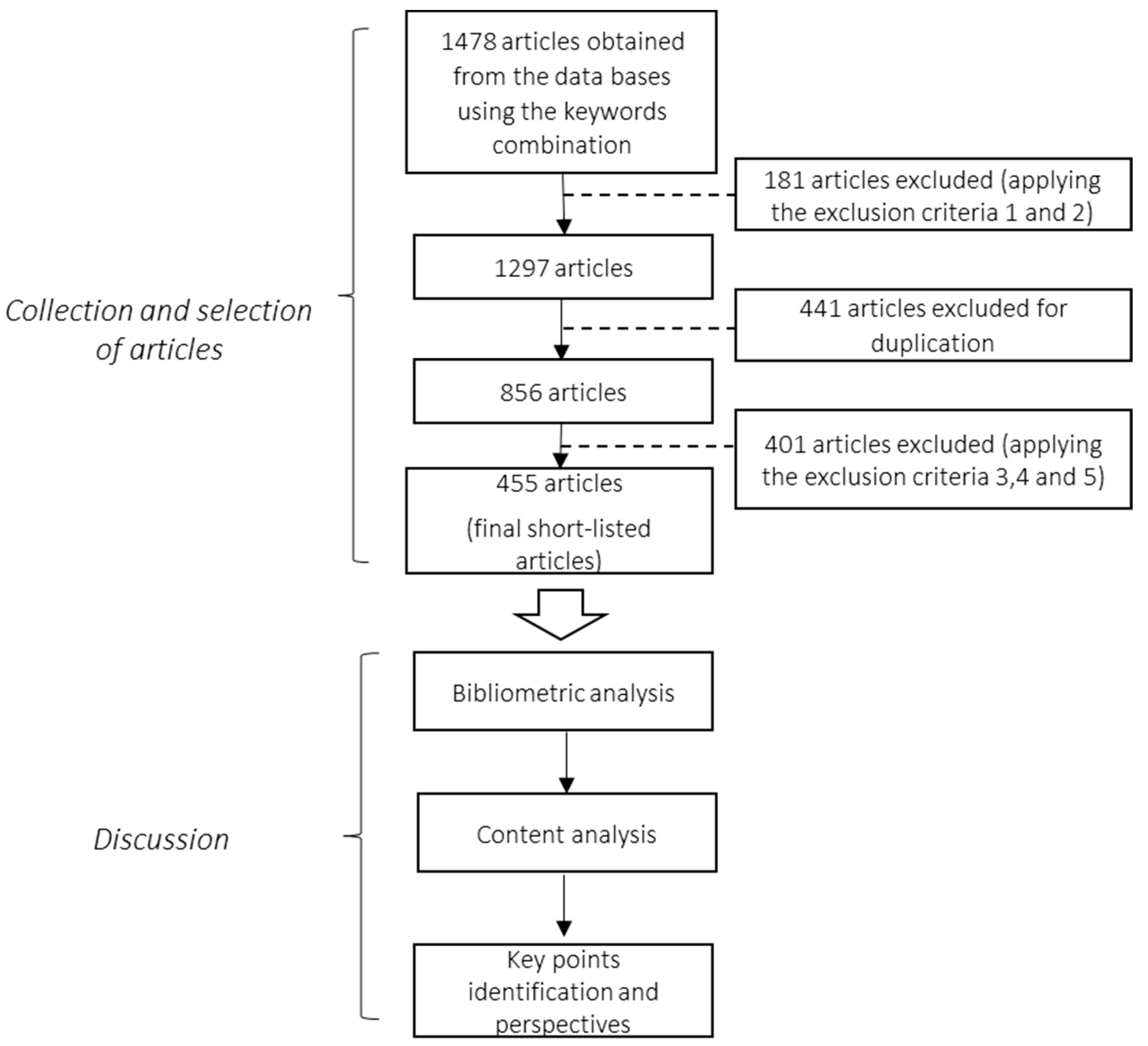
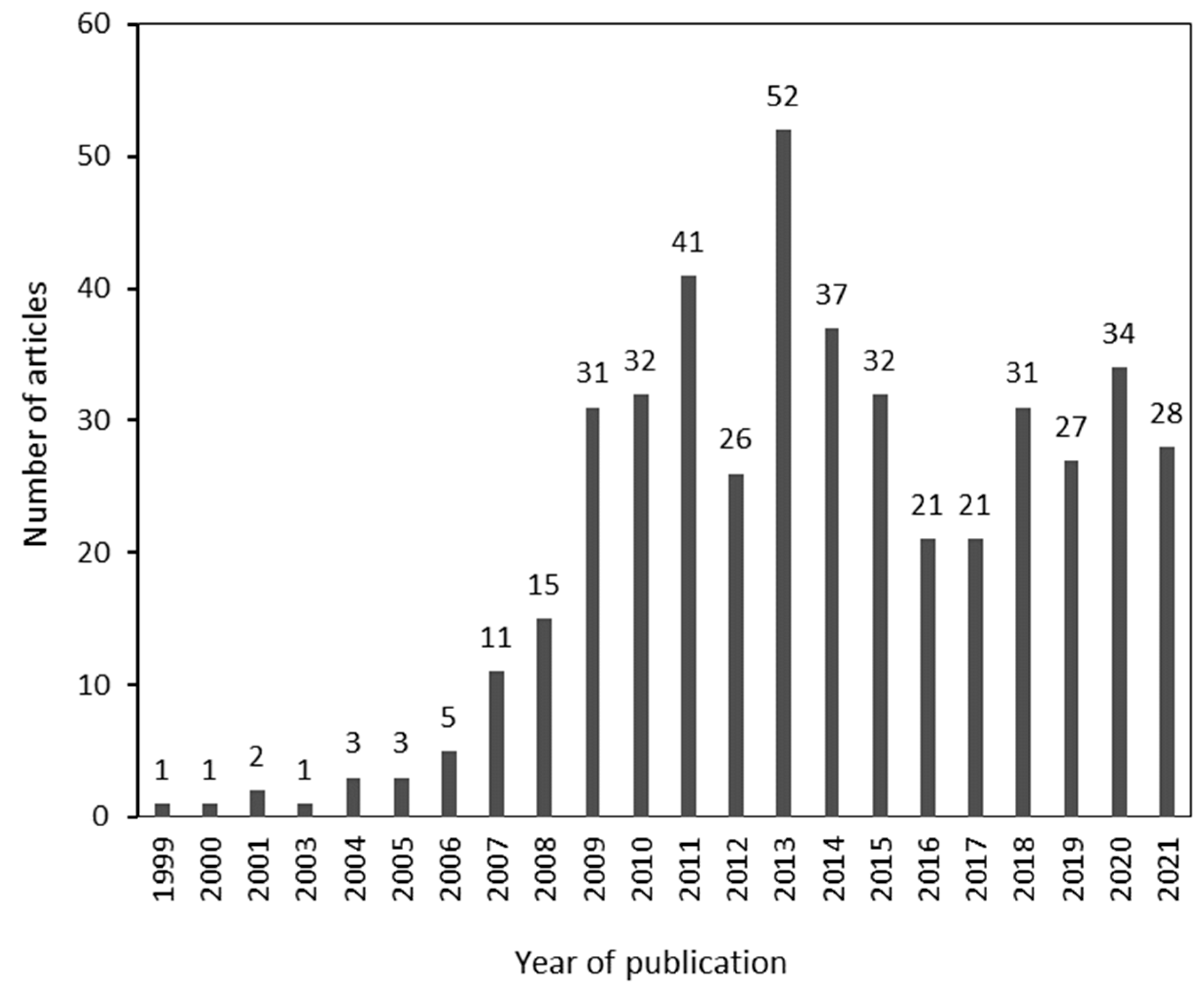
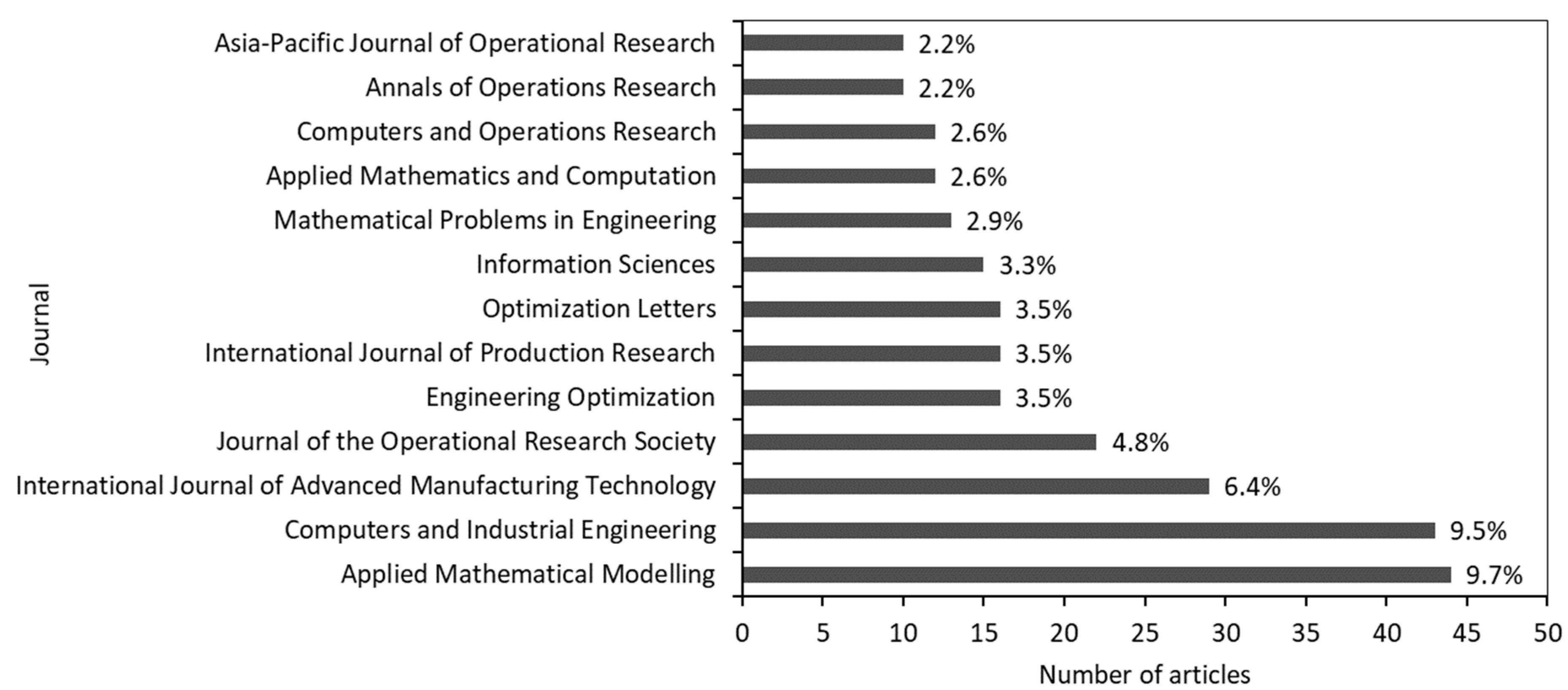

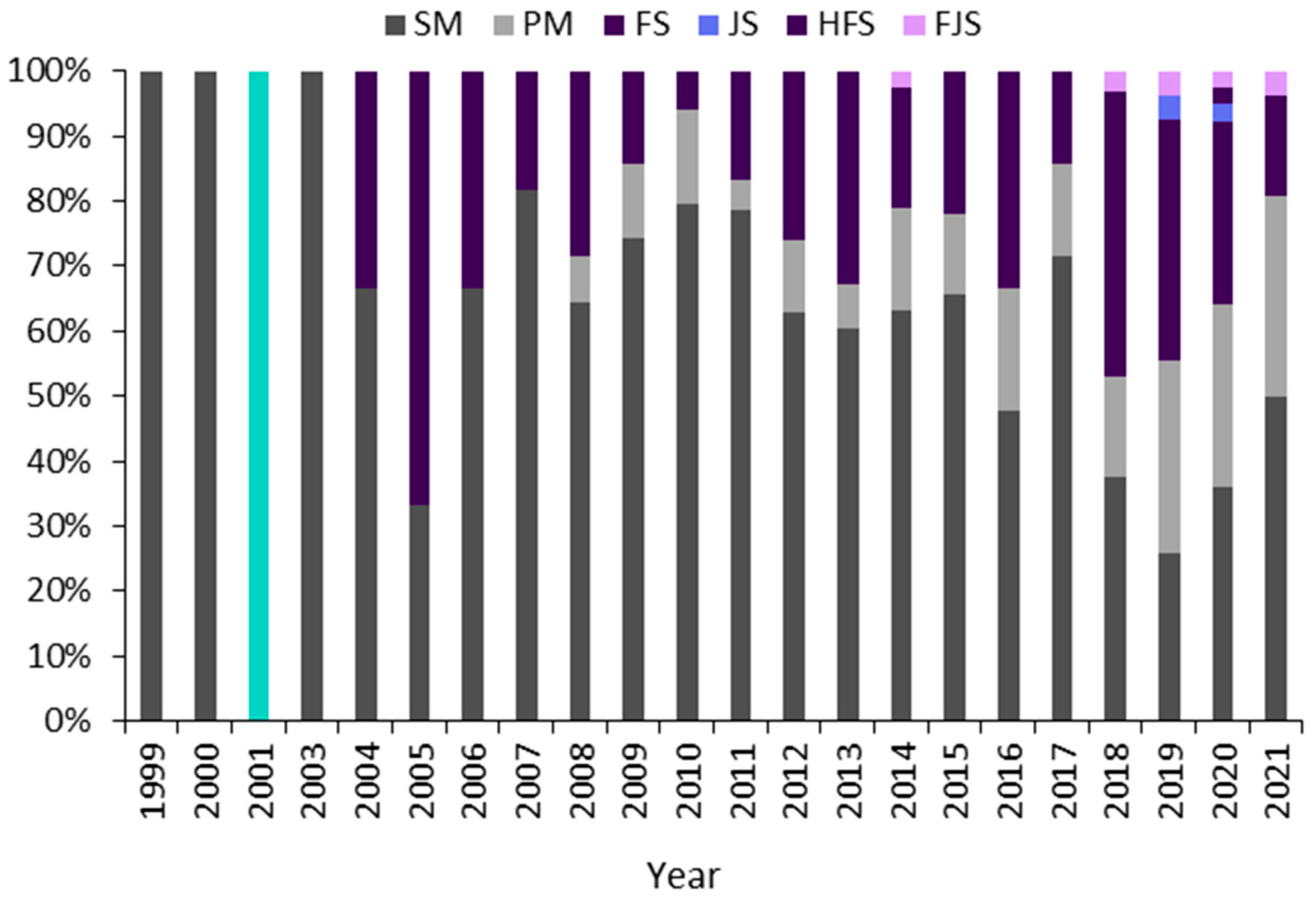
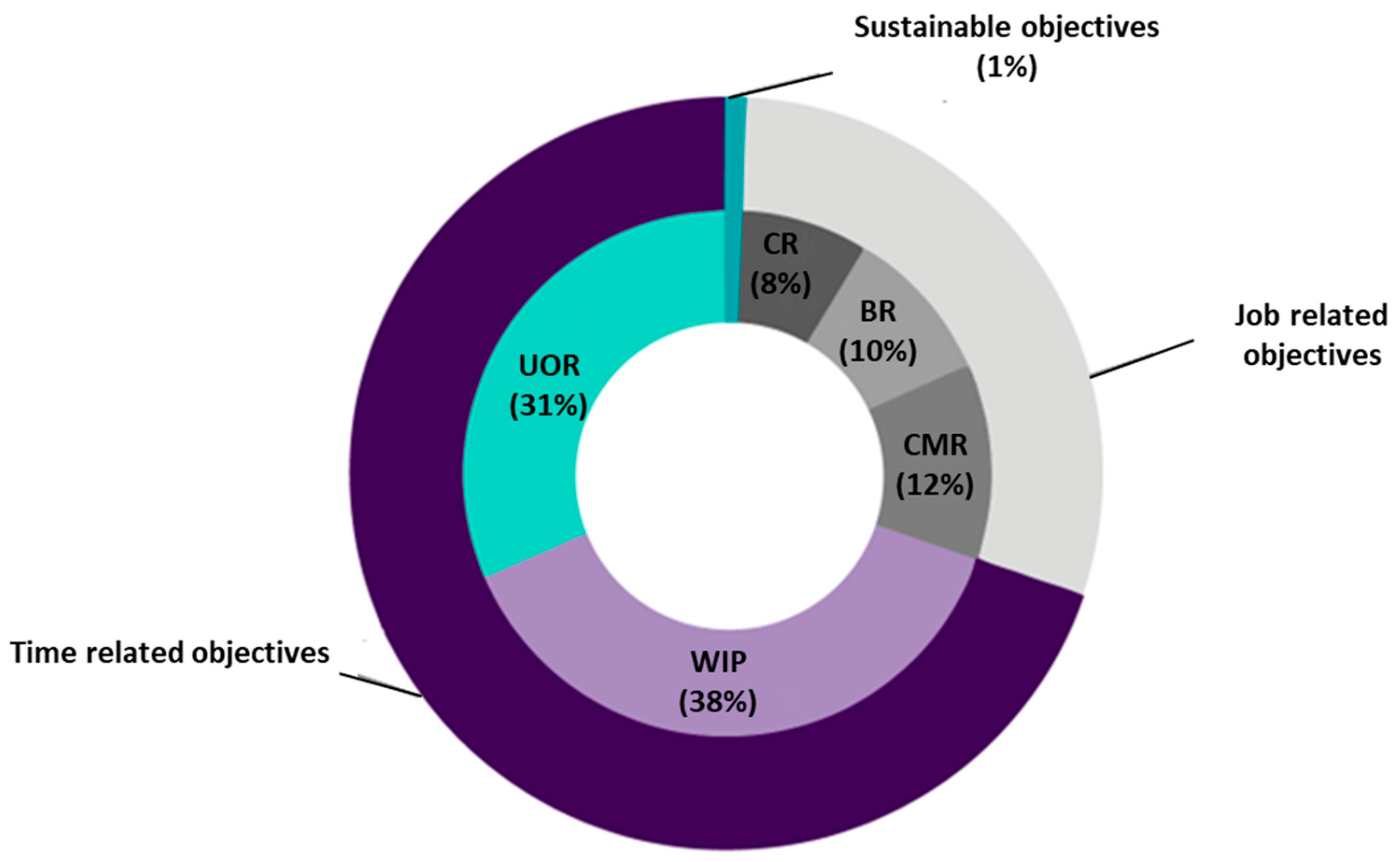
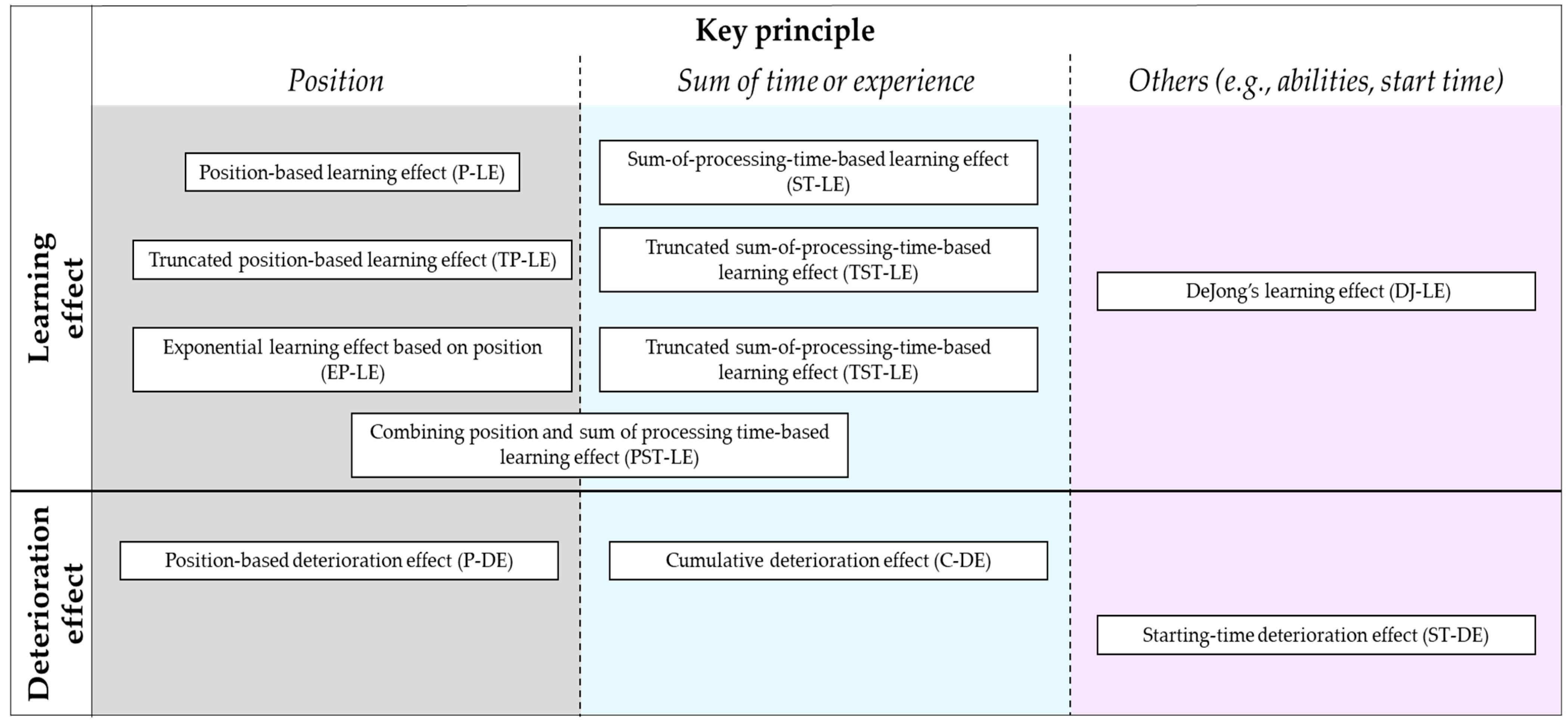
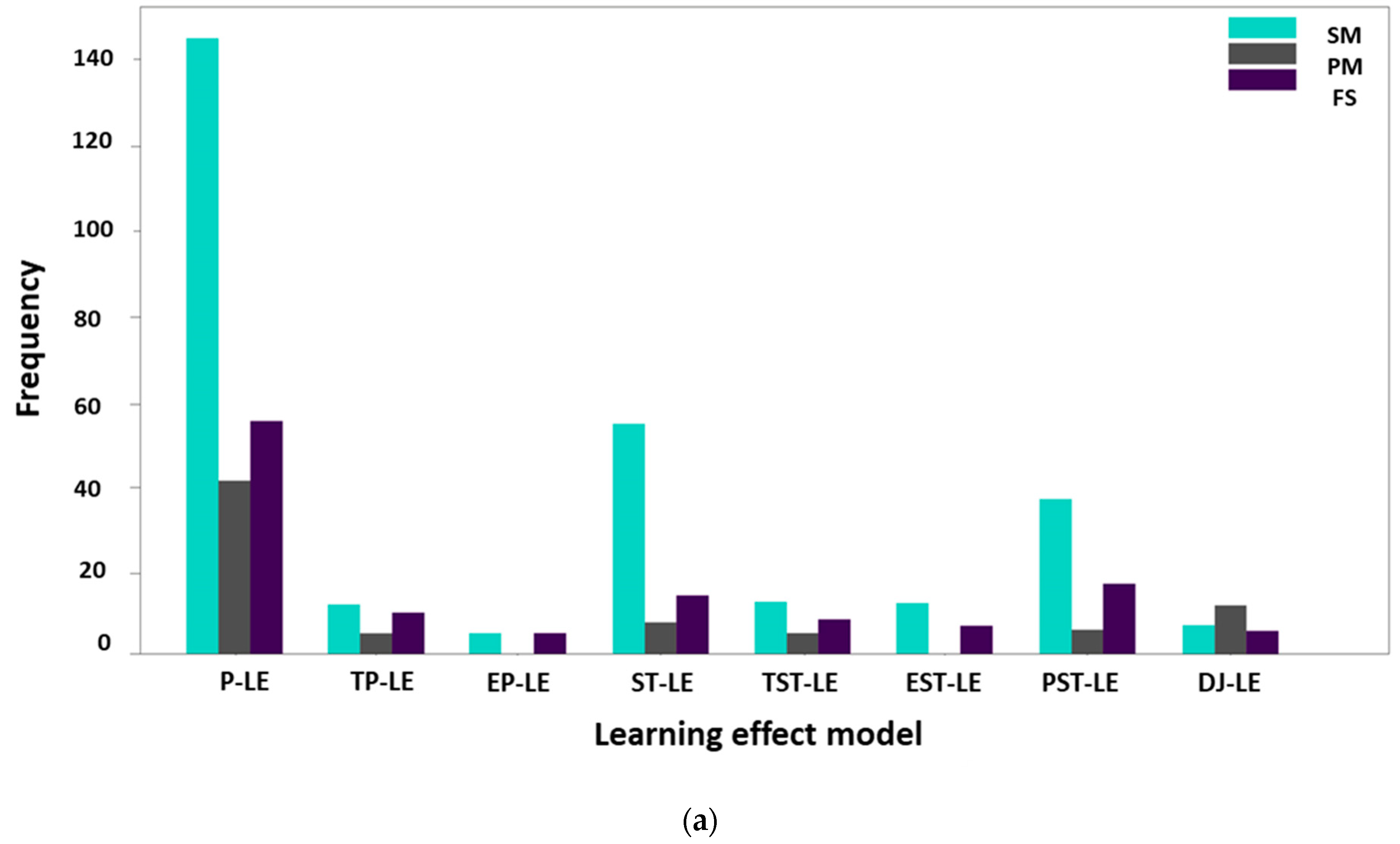
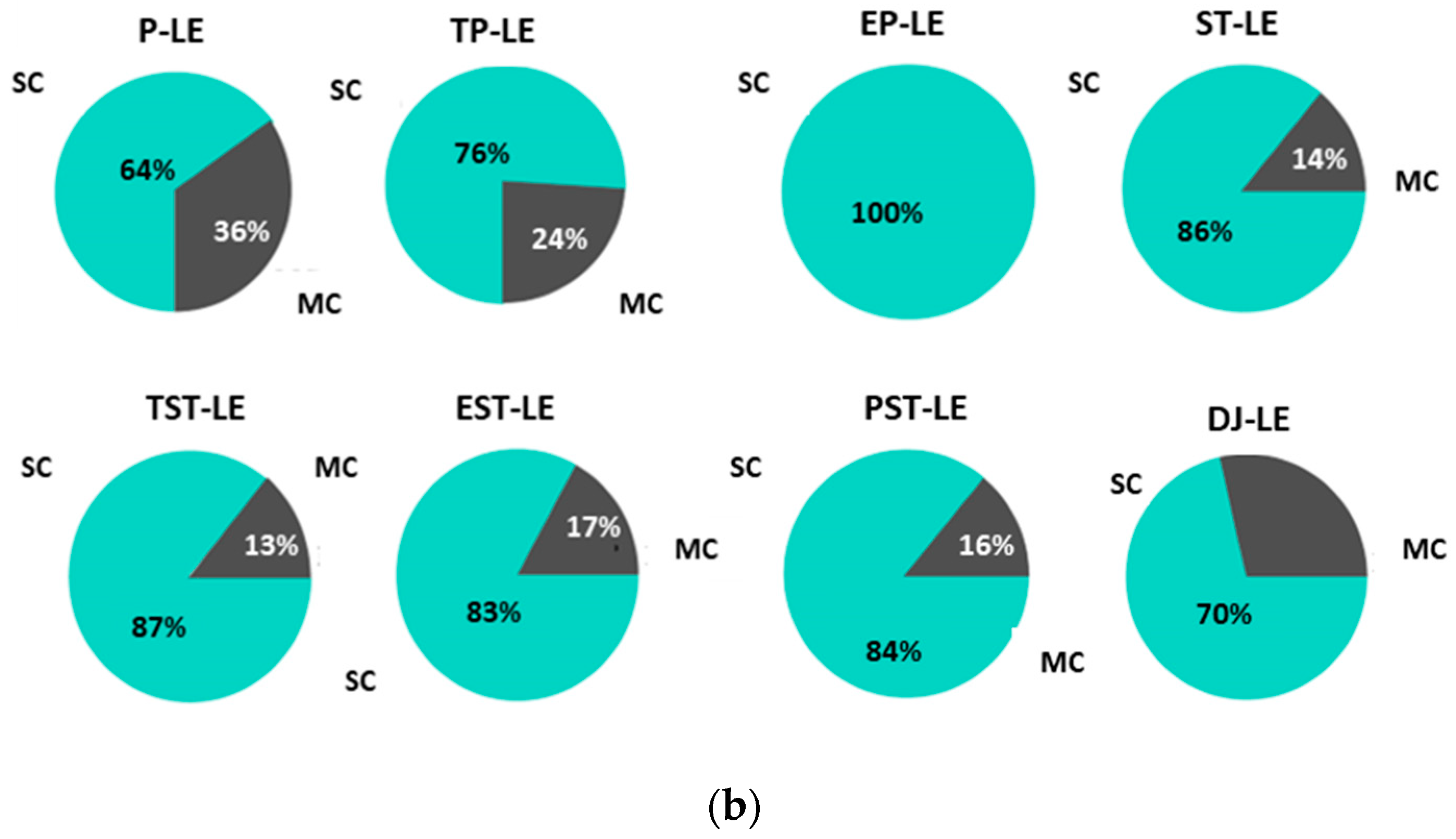
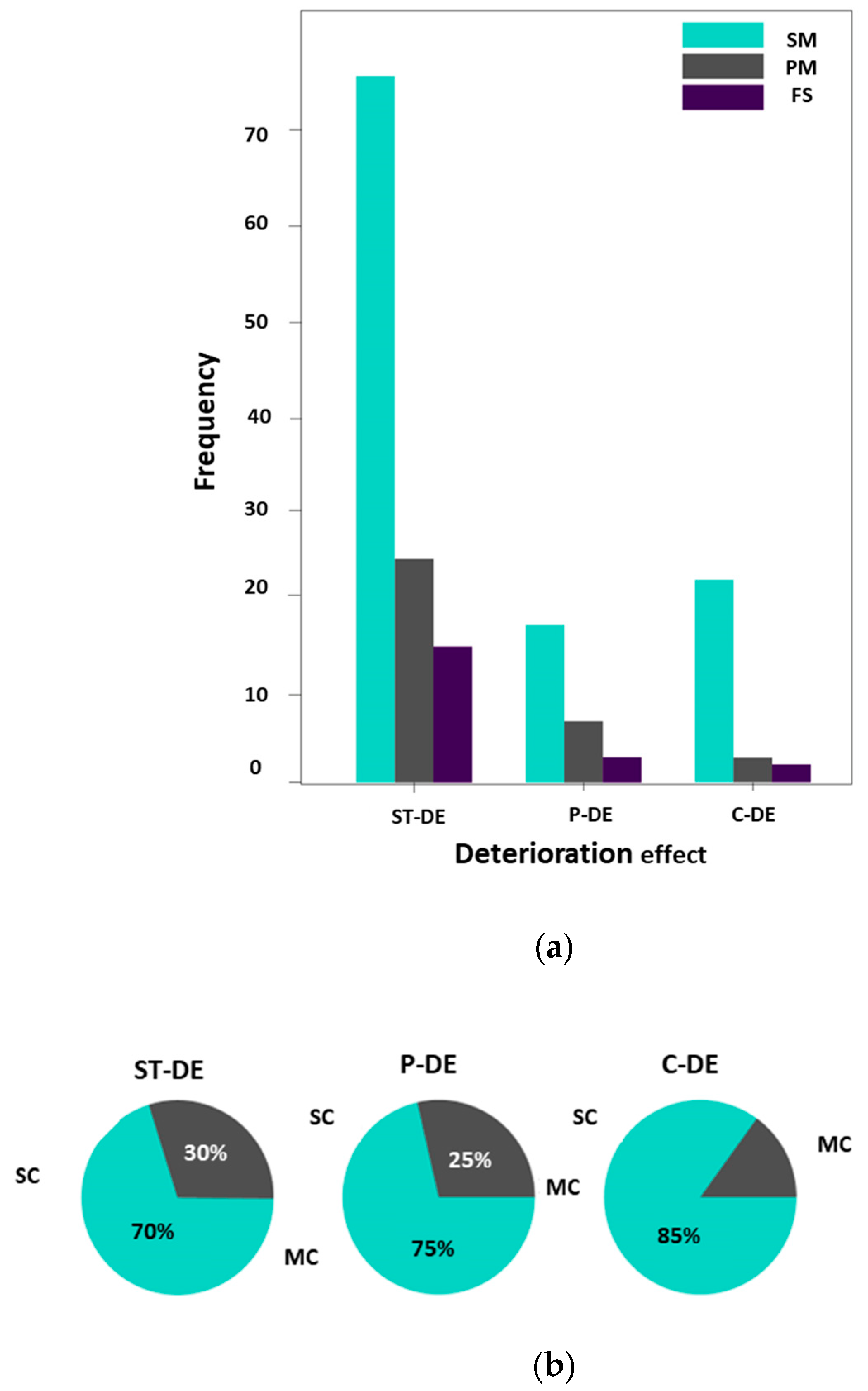
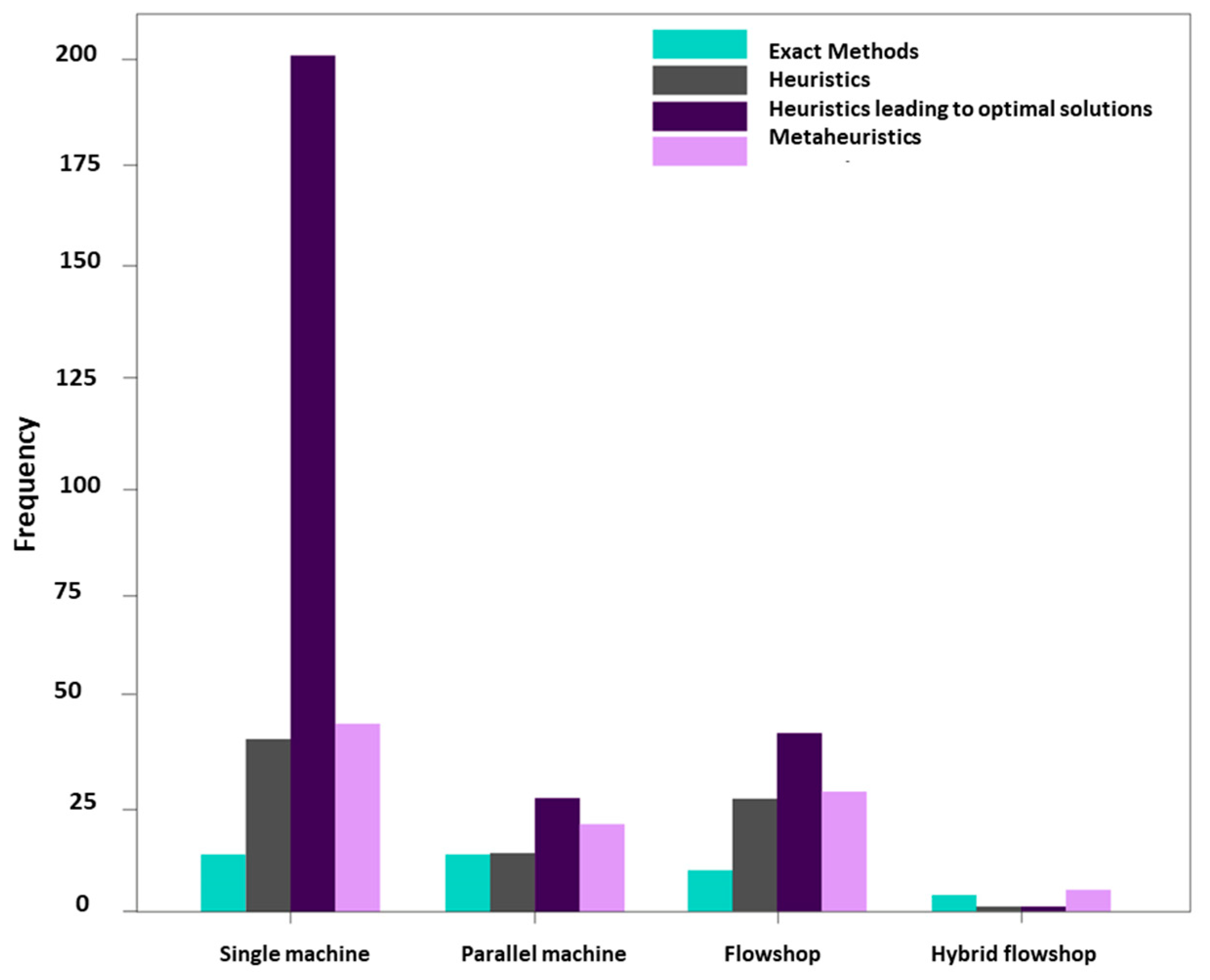
| RQ | Section | Methodologies | Outputs |
|---|---|---|---|
| 1 | Section 3.1 | Bibliometric analysis of the final short-list articles (from Scopus and Web of science). | Identify publications by year, country, distribution of main publishing journals and thematic trends. |
| 2, 3 | Section 3.2 | Classification, descriptive analysis, and content analysis of short-listed articles. | Recognize the common system configuration approach, the types of objective functions and the criteria taken into consideration. |
| 4 | Section 3.3 | Identify relevant models proposed to address the learning and deterioration effect regarding scheduling problems. | |
| 5 | Section 3.4 | Recognize solution methods employed in these problems and the frequency of use. |
| Opportunities | Challenges |
|---|---|
| Approach the problem through complex considerations (e.g., flowshop, hybrid flowshop, flexible shop). | To manage and resolve real instances of the problem in situations of high computational complexity. Capitalize on the few articles that consider complex configurations from the theoretical perspective and bring them closer to reality. |
| Incorporate novel criteria into objective functions. | Look at the industrial partners and identify the objectives they aim to optimize. Go back to articles that integrate increasingly important social and environmental objectives. Create collaborative relationships with industrial stakeholders. |
| Develop models of learning and deterioration effects closer to real human behavior. Accurate estimation of the parameters included in these models. | Carry out multidisciplinary work that aims to incorporate human factor-related tools into scheduling problems. |
| Devise and develop methods of solutions, to resolve the problem within a reasonable time. | Human characteristics may not necessarily be determining factors. Therefore, the integration of methods that address the problem and address uncertainty will be required. |
Publisher’s Note: MDPI stays neutral with regard to jurisdictional claims in published maps and institutional affiliations. |
© 2022 by the authors. Licensee MDPI, Basel, Switzerland. This article is an open access article distributed under the terms and conditions of the Creative Commons Attribution (CC BY) license (https://creativecommons.org/licenses/by/4.0/).
Share and Cite
Paredes-Astudillo, Y.A.; Montoya-Torres, J.R.; Botta-Genoulaz, V. Taxonomy of Scheduling Problems with Learning and Deterioration Effects. Algorithms 2022, 15, 439. https://doi.org/10.3390/a15110439
Paredes-Astudillo YA, Montoya-Torres JR, Botta-Genoulaz V. Taxonomy of Scheduling Problems with Learning and Deterioration Effects. Algorithms. 2022; 15(11):439. https://doi.org/10.3390/a15110439
Chicago/Turabian StyleParedes-Astudillo, Yenny Alexandra, Jairo R. Montoya-Torres, and Valérie Botta-Genoulaz. 2022. "Taxonomy of Scheduling Problems with Learning and Deterioration Effects" Algorithms 15, no. 11: 439. https://doi.org/10.3390/a15110439
APA StyleParedes-Astudillo, Y. A., Montoya-Torres, J. R., & Botta-Genoulaz, V. (2022). Taxonomy of Scheduling Problems with Learning and Deterioration Effects. Algorithms, 15(11), 439. https://doi.org/10.3390/a15110439







